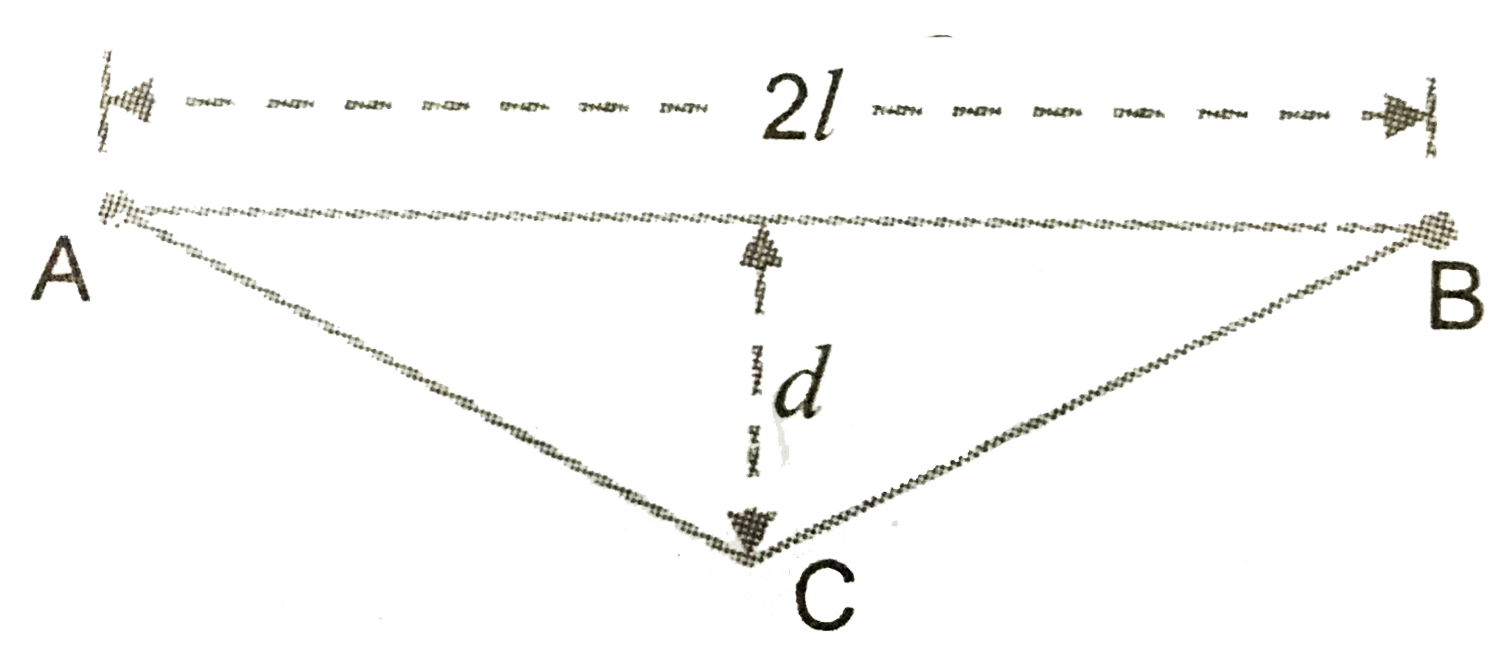A wire of radius r stretched without tension along a straight line is tightly fixed at A and B. What is the tension in the wire when it is pulled in the shape ACB? Assume Young's modulus of material of the wire to be Y.

Let 2l be the original length of wire AB, i.e., L = 2l, when wire is pulled into shape ACB, the increase in length,
ΔL=(AC+CB)−AB
=2(l2+d2)1/2−2l
longitudinal strain =ΔLL
=2(l2+d2)1/2−2l2l
=2l[1+(d2l2)1/2−1]2l
=[1+12d2l2−1]=d22l2
longitudinal stress =tensionarea=Fπr2
∴ Young's modulus,
Y=longitudinal stresslongitudinal strain
F/πr2d2/2l2
∴ Tension in the wire
F=Y×πr2×d22l2
Topper's Solved these Questions
- PROPERTIES OF MATTERBOOK - PREMIERS PUBLISHERSCHAPTER - PROPERTIES OF MATTEREXERCISE - OTHER IMPORTANT QUESTION & ANSWERS (CONCEPTUAL QUESTIONS)
84 Videos
- OSCILLATIONS BOOK - PREMIERS PUBLISHERSCHAPTER - OSCILLATIONS EXERCISE - OTHER IMPORTANT QUESTIONS & ANSWERS ( CONCEPTUAL QUESTIONS.)
24 Videos
- QUESTION PAPER MARCH 2019BOOK - PREMIERS PUBLISHERSCHAPTER - QUESTION PAPER MARCH 2019EXERCISE - Part- IV
23 Videos
Similar Questions
A wire of radius r stretched without tension along a straight line is tightly fixed at A and B. fig. What is the tension in the wire when it is pulled in the shape ACB? Assume Uoung's modulus of material of the wire to by Y.

View SolutionA steel wire of radius r is stretched without tension along a straight line with its ends fixed at A and B (figure). The wire is pulled into the shape ACB. Assume that d is very small compared to length of the wire. Young’s modulus of steel is Y.
(a) What is the tension (T) in the wire?
(b) Determine the pulling force F. Is F larger than T?

View Solution
Knowledge Check
A uniform wire of density ρ is stretched by l! under its propotional limit whose original slength is L. What is lowest frequency of transverse viberation set up in the wire assuming Young's modulus of the material to be Y?
A12L√Yl1ρLB14L√YlρL1C12L√Yl1ρL1D1L√Yl1ρLWhen a wire is stretched by a force the strain produced in the wire is 2×10−4. If the energy stored per unit volume of the wire is 4×104joule/m3 then the Young's modulus of the material of the wire will be,
A1×1012N/m2B1.5×1012N/m2C2×1012N/m2D2.5×1012N/m2A steel wire is stretched with a definite load. If the Young's modulus of the wire is Y. For decreasing the value of Y.
Aradius should be increasedBradius should be decreasedClength should be increasedDnone
A uniform wire of density ρ is stretched by l! under its propotional limit whose original slength is L. What is lowest frequency of transverse viberation set up in the wire assuming Young's modulus of the material to be Y?
View SolutionA steel wire is stretched with a definite load. If the Young's modulues of the wire is Y. For decreasing the value of Y.
View SolutionA steel wire is stretched by 5kwt. If the radius of the wire is doubled its Young's modulus
View SolutionIn a stretched wire under tension and fixed at both ends, the area of cross section of the wire is halved and the tension is doubled. The frequency of the wire will be
View SolutionA wire of length L and area of cross-section A, is stretched by a load. The elongation produced in the wire is I. If Y is the Young's modulus of the material of the wire, then the force constant of the wire is
View Solution
